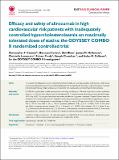| dc.contributor.author | Cannon, Christopher P. | en_US |
| dc.contributor.author | Cariou, Bertrand | en_US |
| dc.contributor.author | Blom, Dirk | en_US |
| dc.contributor.author | McKenney, James M. | en_US |
| dc.contributor.author | Lorenzato, Christelle | en_US |
| dc.contributor.author | Pordy, Robert | en_US |
| dc.contributor.author | Chaudhari, Umesh | en_US |
| dc.contributor.author | Colhoun, Helen M. | en_US |
| dc.date.accessioned | 2015-06-02T12:22:17Z | |
| dc.date.issued | 2015 | en_US |
| dc.identifier.citation | Cannon, Christopher P., Bertrand Cariou, Dirk Blom, James M. McKenney, Christelle Lorenzato, Robert Pordy, Umesh Chaudhari, and Helen M. Colhoun. 2015. “Efficacy and safety of alirocumab in high cardiovascular risk patients with inadequately controlled hypercholesterolaemia on maximally tolerated doses of statins: the ODYSSEY COMBO II randomized controlled trial.” European Heart Journal 36 (19): 1186-1194. doi:10.1093/eurheartj/ehv028. http://dx.doi.org/10.1093/eurheartj/ehv028. | en |
| dc.identifier.issn | 0195-668X | en |
| dc.identifier.uri | http://nrs.harvard.edu/urn-3:HUL.InstRepos:16121040 | |
| dc.description.abstract | Aims To compare the efficacy [low-density lipoprotein cholesterol (LDL-C) lowering] and safety of alirocumab, a fully human monoclonal antibody to proprotein convertase subtilisin/kexin 9, compared with ezetimibe, as add-on therapy to maximally tolerated statin therapy in high cardiovascular risk patients with inadequately controlled hypercholesterolaemia. Methods and results COMBO II is a double-blind, double-dummy, active-controlled, parallel-group, 104-week study of alirocumab vs. ezetimibe. Patients (n = 720) with high cardiovascular risk and elevated LDL-C despite maximal doses of statins were enrolled (August 2012–May 2013). This pre-specified analysis was conducted after the last patient completed 52 weeks. Patients were randomized to subcutaneous alirocumab 75 mg every 2 weeks (plus oral placebo) or oral ezetimibe 10 mg daily (plus subcutaneous placebo) on a background of statin therapy. At Week 24, mean ± SE reductions in LDL-C from baseline were 50.6 ± 1.4% for alirocumab vs. 20.7 ± 1.9% for ezetimibe (difference 29.8 ± 2.3%; P < 0.0001); 77.0% of alirocumab and 45.6% of ezetimibe patients achieved LDL-C <1.8 mmol/L (P < 0.0001). Mean achieved LDL-C at Week 24 was 1.3 ± 0.04 mmol/L with alirocumab and 2.1 ± 0.05 mmol/L with ezetimibe, and were maintained to Week 52. Alirocumab was generally well tolerated, with no evidence of an excess of treatment-emergent adverse events. Conclusion: In patients at high cardiovascular risk with inadequately controlled LDL-C, alirocumab achieved significantly greater reductions in LDL-C compared with ezetimibe, with a similar safety profile. Trial registration clinicaltrials.gov Identifier: NCT01644188. | en |
| dc.language.iso | en_US | en |
| dc.publisher | Oxford University Press | en |
| dc.relation.isversionof | doi:10.1093/eurheartj/ehv028 | en |
| dc.relation.hasversion | http://www.ncbi.nlm.nih.gov/pmc/articles/PMC4430683/pdf/ | en |
| dash.license | LAA | en_US |
| dc.subject | Alirocumab | en |
| dc.subject | Ezetimibe | en |
| dc.subject | Low-Density Lipoprotein Cholesterol | en |
| dc.subject | Monoclonal antibody | en |
| dc.title | Efficacy and safety of alirocumab in high cardiovascular risk patients with inadequately controlled hypercholesterolaemia on maximally tolerated doses of statins: the ODYSSEY COMBO II randomized controlled trial | en |
| dc.type | Journal Article | en_US |
| dc.description.version | Version of Record | en |
| dc.relation.journal | European Heart Journal | en |
| dash.depositing.author | Cannon, Christopher P. | en_US |
| dc.date.available | 2015-06-02T12:22:17Z | |
| dc.identifier.doi | 10.1093/eurheartj/ehv028 | * |
| dash.contributor.affiliated | Cannon, Christopher | |


